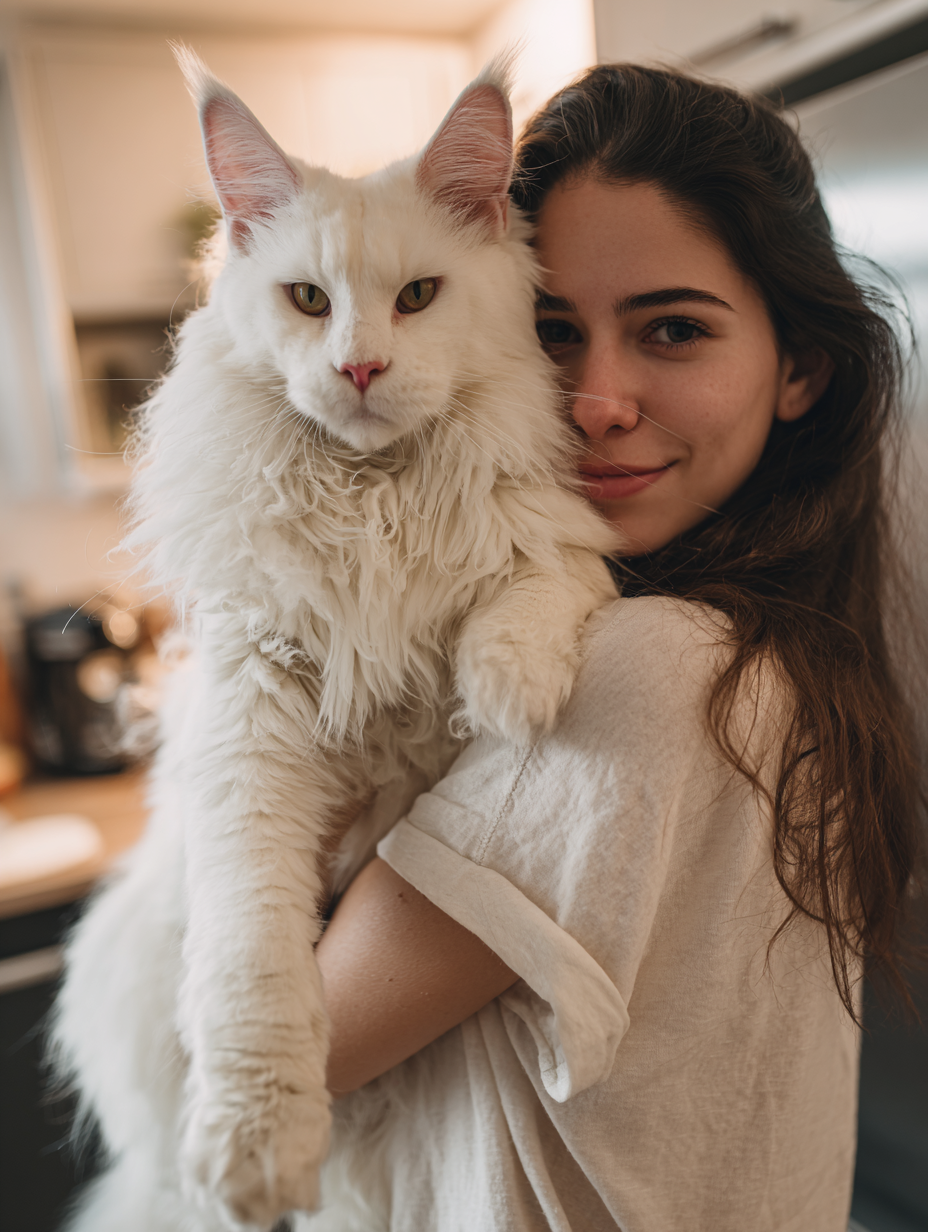
American vs European Maine Coon: What’s the Real Difference?
The Maine Coon is one of the most recognizable cat breeds in the world, but not all Maine Coons look exactly the same. Over the years, two distinct lines have developed—American and European. While both share the same origins, they differ in size, facial structure, coat texture, and overall type due to regional breeding goals.
If you’ve ever compared photos of Maine Coons and noticed one looks wilder or more rugged than the other, you were likely seeing a European Maine Coon. This guide explains how the American and European types developed, what sets them apart, and which one might suit your preferences or breeding goals.
Searching for a European Line Maine Coon Kitten?
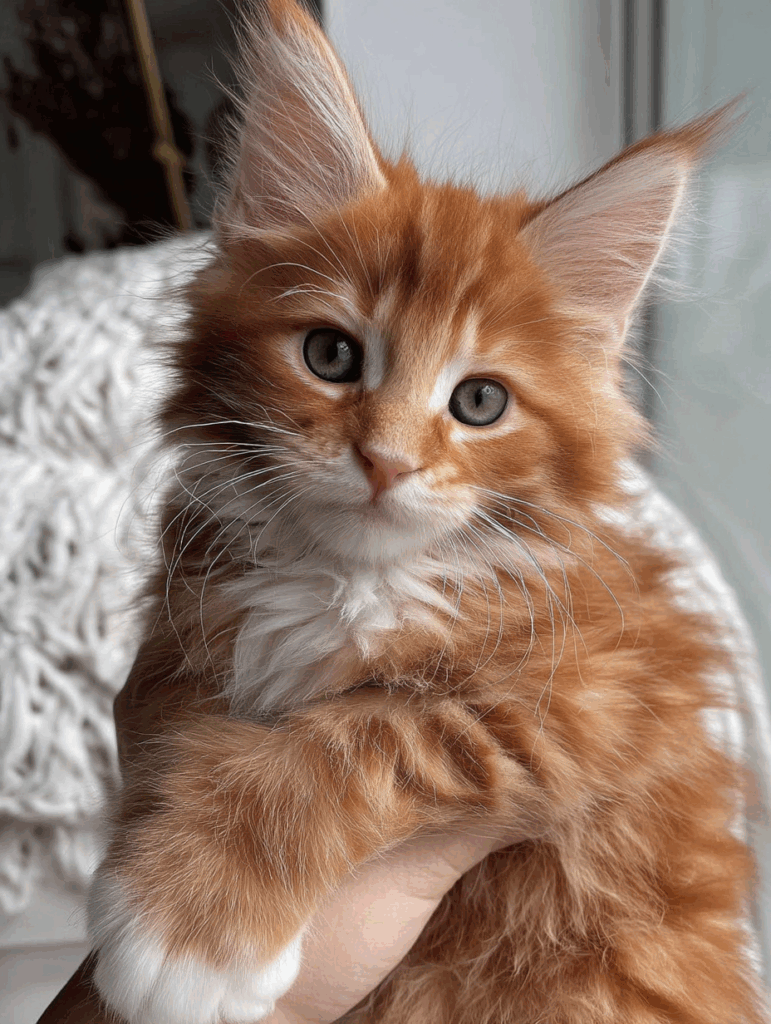
If you are searching for and authentic European Maine Coon Kitten, check out our Purebred Maine Coon Kittens for Sale.
At Almonte Cats, every kitten is:
- TICA / CFA registered from fully health-tested parents
- Raised in-home for confident, affectionate temperaments
- Vet-checked, vaccinated, and microchipped before going home
Reserve early — our litters are produced in limited numbers each year to preserve quality and true Maine Coon type.
View Available Kittens & Apply Here
The Origin of the American and European Maine Coon
All Maine Coons trace back to the same foundation cats in North America, particularly New England, where they developed naturally. As the breed gained popularity, Maine Coons were exported to Europe. Over time, breeders in each region emphasized different features based on personal preference and show standards.
American breeders generally selected for balance and softness—rounded lines, moderate ear tufts, and symmetrical faces. European breeders, influenced by trends favoring bold and wild looks, focused on strong muzzles, larger frames, and pronounced ear tufts.
Both are authentic Maine Coons with shared ancestry. The divergence lies in selective breeding priorities rather than genetics or legitimacy. See photos of baby Maine Coon Kittens here.
European Maine Coon Appearance
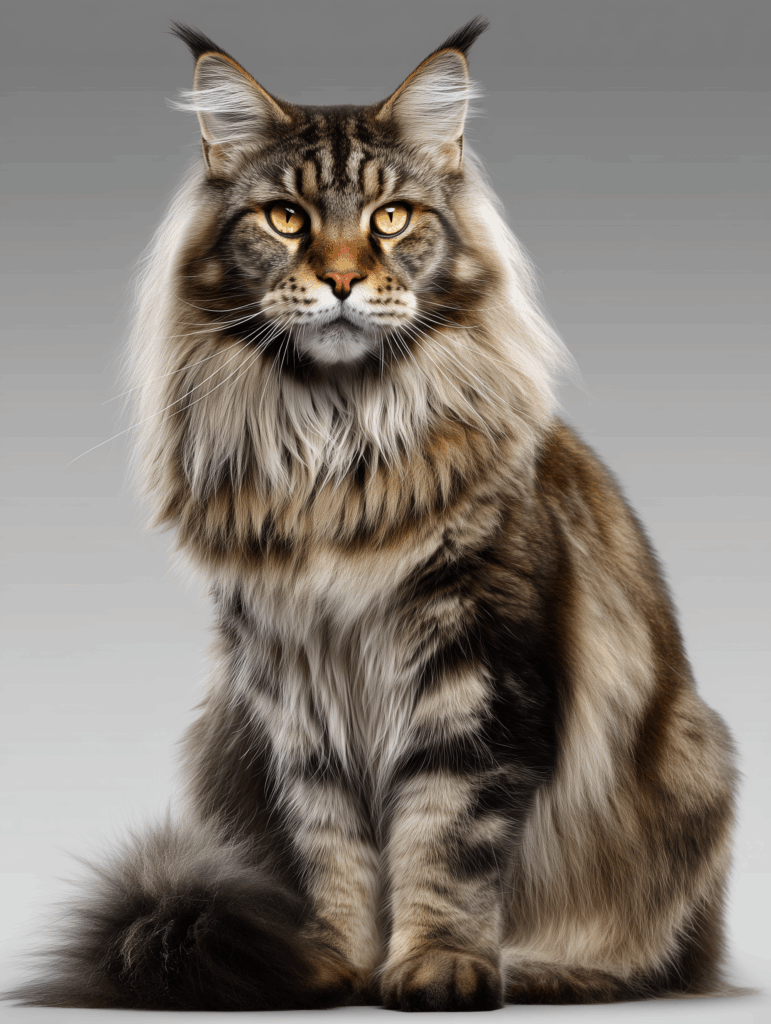
European Maine Coons are instantly recognizable for their striking, wild appearance. They typically have:
- A long rectangular body with heavy bone structure
- A pronounced square muzzle and broad jaw
- Tall, wide-set ears with long tufts
- A slightly sloped forehead and deeper eye set
Their coats are thick, shaggy, and weatherproof, often giving them a more rugged look. European Maine Coons also tend to have longer hind legs, creating a slightly elevated stance. Their faces photograph dramatically due to high cheekbones and angular features.
In terms of size, European males often weigh between 18 and 25 pounds, and females 12 to 16. They reach their full growth at around four years old, developing strong muscle tone and a lion-like mane.
American Maine Coon Appearance
The American Maine Coon preserves a more moderate and traditional type. These cats often resemble the breed’s early show lines from the 1970s and 1980s—balanced, soft, and elegant rather than extreme.
Typical traits include:
- A medium-long rectangular body
- Softer facial contours and rounded muzzle
- Slightly shorter ears with moderate tufts
- Large, expressive eyes and a gentle expression
The coat of the American Maine Coon is dense but smoother in texture compared to the heavier European coat. Their head structure appears rounder, and the transition from forehead to nose is less steep. While still large, they tend to weigh slightly less than their European counterparts—males averaging 15 to 20 pounds and females 10 to 14.
European vs American Maine Coon Personality
Both American and European Maine Coons share the same affectionate, intelligent, and playful temperament. Their personalities remain consistent regardless of type because both lines stem from the same foundation cats.
The difference is often in energy level and confidence. European Maine Coons are sometimes described as bolder and more independent, while American lines are known for their relaxed, social nature. However, much of this variation comes down to environment and early socialization rather than genetics.
Owners of both types praise their Maine Coons for being dog-like companions—following them around, greeting visitors, and learning commands easily. Regardless of origin, these cats adapt well to families, children, and even other pets.
Size and Structure Comparison
| Trait | European Maine Coon | American Maine Coon |
|---|---|---|
| Average Male Weight | 18–25 lbs | 15–20 lbs |
| Average Female Weight | 12–16 lbs | 10–14 lbs |
| Body Type | Long, heavy-boned, muscular | Medium-long, balanced, softer |
| Muzzle Shape | Square and prominent | Rounded, moderate |
| Ears | Large, tall, with long tufts | Medium, well-tufted |
| Coat Texture | Shaggy, dense, rugged | Smooth, soft, even |
| Head Shape | Angular, strong cheekbones | Rounded, gentle lines |
| Expression | Intense, wild look | Sweet, open look |
While both types meet official breed standards, European Maine Coons usually appear larger and more dramatic, while American lines present a classic, polished version of the breed. See Maine coon kitten growth stages week by week here.
European Maine Coon Size and Growth
European Maine Coons are known for their impressive scale. Males can grow up to 40 inches long with tails nearly as long as their bodies. Their growth rate is slower than average domestic cats, taking three to four years to reach maturity.
Their dense bone structure and long legs give them a heavier stance. The thick mane, chest ruff, and pronounced shoulders add visual mass. Because European breeders often prioritize structure and type over color, these cats consistently maintain strong physical characteristics from generation to generation.
Despite their size, they remain agile and athletic, capable of climbing, jumping, and running with ease. Their combination of size and balance is what makes the European Maine Coon so visually commanding.
European vs American Maine Coon Head Shape
One of the easiest ways to distinguish between the two types is by looking at the head. European Maine Coons have a long, rectangular face with a pronounced muzzle and high cheekbones. Their forehead slopes gently toward a straight nose, giving them a powerful, almost wild profile.
In contrast, the American Maine Coon has a softer, rounder face. The transition from forehead to nose is more curved, and the cheekbones are less pronounced. The overall expression is sweeter and more domestic.
Photographs often exaggerate these differences—European lines look more “fierce,” while American lines appear more “friendly.” Both are correct interpretations of the breed; they simply emphasize different aesthetic priorities.
Choosing Between an American and European Maine Coon
Your choice comes down to preference. If you’re drawn to bold structure, heavy bone, and dramatic facial features, the European Maine Coon will appeal most. If you prefer a balanced, traditional look with the same affectionate personality, the American type is ideal.
Both are genuine Maine Coons and make wonderful companions. The distinction is cosmetic rather than behavioral, and both types are equally affectionate, trainable, and intelligent.
At Almonte Cats, we specialize in European Maine Coons, bred for their size, bone, and structure while maintaining the breed’s gentle temperament.
Coat Differences Between European and American Maine Coons
The Maine Coon’s coat is one of its most defining features, and regional breeding priorities have made small but noticeable differences between American and European lines.
European Maine Coons generally have thicker, more textured coats with stronger guard hairs. Their fur tends to stand out slightly from the body, creating a rugged, three-dimensional look. This is especially visible around the chest, shoulders, and hindquarters, where the coat forms a dense ruff and breeches. Their coats are designed to handle colder climates and give them that “forest cat” appearance.
American Maine Coons, by comparison, often display sleeker, more even coats. The texture is still dense and water-resistant, but the fur lies flatter, giving a more polished outline. This coat type highlights their refined structure and makes grooming a little easier for pet owners.
Color ranges overlap entirely between both types. You’ll find the same variety—brown tabby, black smoke, silver, red, blue, and cream—whether the cat is European or American. However, European breeders sometimes focus on darker, more intense color contrasts, while American lines include more show-style patterns like silver tabby or shaded colors.
Eye Shape and Expression
Eye shape plays a major role in differentiating American and European Maine Coons.
European lines often have slightly almond-shaped eyes with a deeper, more intense expression. The overall face structure contributes to this, with high cheekbones and a sloped forehead that enhances their “wild” or “wolfish” gaze. In photography, this gives them a commanding, exotic look that stands out in show halls and online galleries.
American Maine Coons usually feature rounder, open eyes that emphasize sweetness and intelligence. This softer expression aligns with their overall balanced build and contributes to their friendly, approachable presence.
Both eye shapes fall within the official breed standards of CFA and TICA. The variation reflects personal breeder preference rather than separate genetics.
European vs American Maine Coon Temperament
The Maine Coon’s temperament is one of the breed’s biggest selling points—and the good news is that it doesn’t change much between lines. Both American and European Maine Coons are affectionate, confident, and sociable cats that bond closely with their people.
Owners often describe the European Maine Coon as slightly more independent and observant. They can be calm yet curious, always aware of what’s going on around them but not overly demanding of attention. Many breeders describe them as having a “watchful” or “majestic” personality, fitting their strong visual presence.
The American Maine Coon, on the other hand, is known for its easygoing, family-oriented nature. They’re often described as “dog-like”—following people around, greeting visitors, and showing enthusiasm for play and training. Their even temperament makes them one of the best breeds for homes with children or other pets.
While these differences are subtle, they reflect generations of selective breeding. European breeders emphasize physical type, while American programs have long prioritized temperament and trainability.
Size Comparison: European vs American Maine Coon
Size is one of the most discussed differences between these two types. Both are large cats by any measure, but European Maine Coons are generally more robust in bone and frame.
European males commonly reach 18–25 pounds and can exceed 40 inches in total length, tail included. Females usually weigh 12–16 pounds. Their growth continues slowly for up to four years, giving them a heavy, muscular feel.
American Maine Coons are slightly lighter, with males averaging 15–20 pounds and females 10–14 pounds. They also take about three years to reach full maturity. Though lighter in weight, they often have better coat balance and symmetry, reflecting show-standard proportions.
Visually, the European Maine Coon appears more dramatic, while the American type looks more elegant. Both maintain the same rectangular body structure, long tail, and powerful stance that define the breed.
European vs American Maine Coon Breeding Goals
The differences between these two lines are largely shaped by breeder focus.
European breeders tend to emphasize bone structure, head type, and coat texture. Their goal is a bold, strong Maine Coon that looks like a natural forest cat. As a result, you’ll see more angular faces, larger ears, and heavier coats.
American breeders prioritize balance, health, and the classic show-ring look recognized by major U.S. associations. They strive for harmony in structure rather than exaggeration—large, but not extreme; beautiful, but not wild.
Neither approach is right or wrong—they simply reflect differing regional tastes. Today, many breeders carefully blend the two styles to produce cats that combine the refinement of American lines with the strength and type of European bloodlines.
Health and Longevity
Both American and European Maine Coons share the same health considerations. The most common issues in both lines are hypertrophic cardiomyopathy (HCM) and hip dysplasia. Responsible breeders in both regions perform genetic screening and X-rays to minimize these risks.
European lines, due to their heavier structure, sometimes have a slightly higher risk of joint strain if they become overweight. American lines, being a bit lighter, may have fewer orthopedic issues but can still carry the same heart gene mutations.
The average lifespan for both types is 13 to 16 years, depending on lifestyle, nutrition, and genetics. Hybrid vigor occasionally appears in mixed-line pairings, improving health outcomes through genetic diversity.
A well-bred Maine Coon from either region, raised on balanced nutrition and kept at a healthy weight, can easily live into its late teens.
Cost Comparison
Because of international breeding logistics and import costs, European Maine Coons are typically more expensive. In the United States, kittens from imported European bloodlines usually start around $4,500 to $6,500, depending on pedigree and color. Breeders invest heavily in transport, registration, and health testing for European imports. Find more info about Maine coon babies here.
American Maine Coons are more widely available and often range between $2,500 and $4,000 for a pet-quality kitten. Show-quality kittens from titled lines may still reach higher prices, but overall, American lines are more accessible for U.S. buyers.
When comparing cost, it’s important to factor in what the breeder includes—registration, testing, vaccines, and socialization. At Almonte Cats, each kitten is health tested, microchipped, and raised with early enrichment regardless of lineage. How much is a Maine Coon?
Which Type Is Right for You?
The choice between an American and European Maine Coon comes down to personal preference.
- Choose a European Maine Coon if you want a bold, heavy-boned cat with a wild, regal look and powerful presence.
- Choose an American Maine Coon if you prefer a softer, balanced look and a sweet, calm companion ideal for families.
Both are authentic Maine Coons, both share the same affectionate nature, and both can be equally impressive when bred responsibly.
If you’re drawn to the dramatic type and larger frame of the European lines, Almonte Cats specializes in importing and preserving those pedigrees with attention to structure, health, and temperament.
View European Maine Coon Kittens for Sale
Are European Maine Coons Better Than American?
Neither is “better”—they are two interpretations of the same historic breed. The European type has been shaped by aesthetic preference, producing a more robust and dramatic look. The American type preserves the balanced, classic image that made the breed famous.
For families, the difference is largely visual. Both are affectionate, loyal, intelligent, and gentle giants. The best choice depends on your lifestyle and your appreciation for either the rugged or refined expression of the Maine Coon breed.
American and European Line Crosses
Some modern breeders are intentionally crossing American and European lines to combine the best of both worlds. These “dual-line” Maine Coons blend the size and structure of European cats with the balanced proportions and friendly expression of American types.
This approach often produces cats that meet international standards while maintaining genetic diversity. Dual-line breeding also helps reduce the risk of inbreeding depression that can occur when lines are too closed.
The result is a cat that looks powerful yet approachable—an ideal representation of what the Maine Coon should be: strong, intelligent, and kind.
Summary
| Feature | European Maine Coon | American Maine Coon |
|---|---|---|
| Origin | Europe (descendants of U.S. imports) | United States (foundation lines) |
| Body Type | Long, large-boned, muscular | Medium-long, moderate |
| Face Shape | Angular with pronounced muzzle | Rounded with soft contours |
| Ears | Large, upright, tufted | Medium with shorter tufts |
| Coat | Dense, textured, rugged | Sleek, even, and soft |
| Eye Shape | Almond, intense | Round, open |
| Size | 18–25 lbs (males) | 15–20 lbs (males) |
| Temperament | Confident, independent | Gentle, social, easygoing |
| Lifespan | 13–16 years | 13–16 years |
| Cost | $4,500–$6,500 | $2,500–$4,000 |
People Also Ask — American vs European Maine Coon FAQ
Are European Maine Coons bigger than American Maine Coons?
Yes, European Maine Coons are generally larger and heavier-boned than their American counterparts. Males often weigh 18–25 pounds, while American males average 15–20. The difference comes from European breeders prioritizing structure and frame, while American programs focus more on balance and proportion.
Why do European Maine Coons look wilder?
European Maine Coons look wilder because of their pronounced muzzle, angular head shape, and tall, tufted ears. Breeders in Europe intentionally selected for bold facial structure and thicker coats, giving them a more rugged, “forest cat” appearance. The result is a cat that looks powerful while maintaining the same calm temperament.
Do American Maine Coons have smaller faces?
Yes, American Maine Coons often have softer, rounder faces with gentler lines. Their expression appears sweeter and more domestic, reflecting the classic look seen in early show lines. The structure is still balanced and strong, just less extreme than the European version.
Is there a difference in temperament between American and European Maine Coons?
Temperament is largely the same between both types—friendly, social, and intelligent. American Maine Coons are sometimes described as more easygoing and family-focused, while European lines may seem more observant and independent. These differences come from environment and handling, not genetics.
Are European Maine Coons healthier than American ones?
Health depends on the breeder rather than region. Both types can carry the same genetic risks for HCM and hip dysplasia. European breeders often emphasize testing for structure and heart health, while American breeders typically follow the same protocols. The key is choosing a breeder who performs full health screening on all breeding cats.
Can I register a European Maine Coon in the U.S.?
Yes, you can register a European Maine Coon with U.S. associations such as CFA or TICA, as long as the pedigree meets their documentation requirements. Many European breeders already dual-register their lines for international recognition. Your breeder should provide registration papers that can be transferred to your preferred association.
Are European Maine Coons more expensive?
Generally, yes. Because of international import fees, health testing, and limited supply, European Maine Coons often cost $4,500 to $6,500 in the U.S. American Maine Coons are more common and range from $2,500 to $4,000. Price reflects pedigree, not personality or quality of care.
How can I tell if my Maine Coon is European or American type?
Look at the facial structure, ear shape, and coat density. European Maine Coons have angular faces, tall ears with strong lynx tips, and thicker coats. American lines have rounder heads, shorter tufts, and a sleeker coat texture. Comparing photos of both types can help, but only your breeder can confirm lineage.
Can European and American Maine Coons be bred together?
Yes, many breeders combine European and American lines to balance structure, health, and temperament. These dual-line Maine Coons often have excellent bone structure with a friendly, classic expression. Blending lines also increases genetic diversity, strengthening the overall health of the breed.
Which Maine Coon type is better for families?
Both American and European Maine Coons make excellent family pets. They are affectionate, patient, and adaptable. The difference is mainly in appearance rather than behavior. As long as the cat comes from a well-socialized litter, either type will thrive in a loving home.
Reading Recommendations
- Maine Coon Size Comparison
- Maine Coon Hybrid Kitten
- Maine Coon Mix Cat Guide
- Maine Coon Photos
- European Genetics Maine Coon Kittens for Sale
External Authority References
- FIFE Maine Coon Breed Profile
- World Cat Congress Maine Coons
- Basepaws Cat DNA Test – Verify your cat’s lineage and genetic markers.
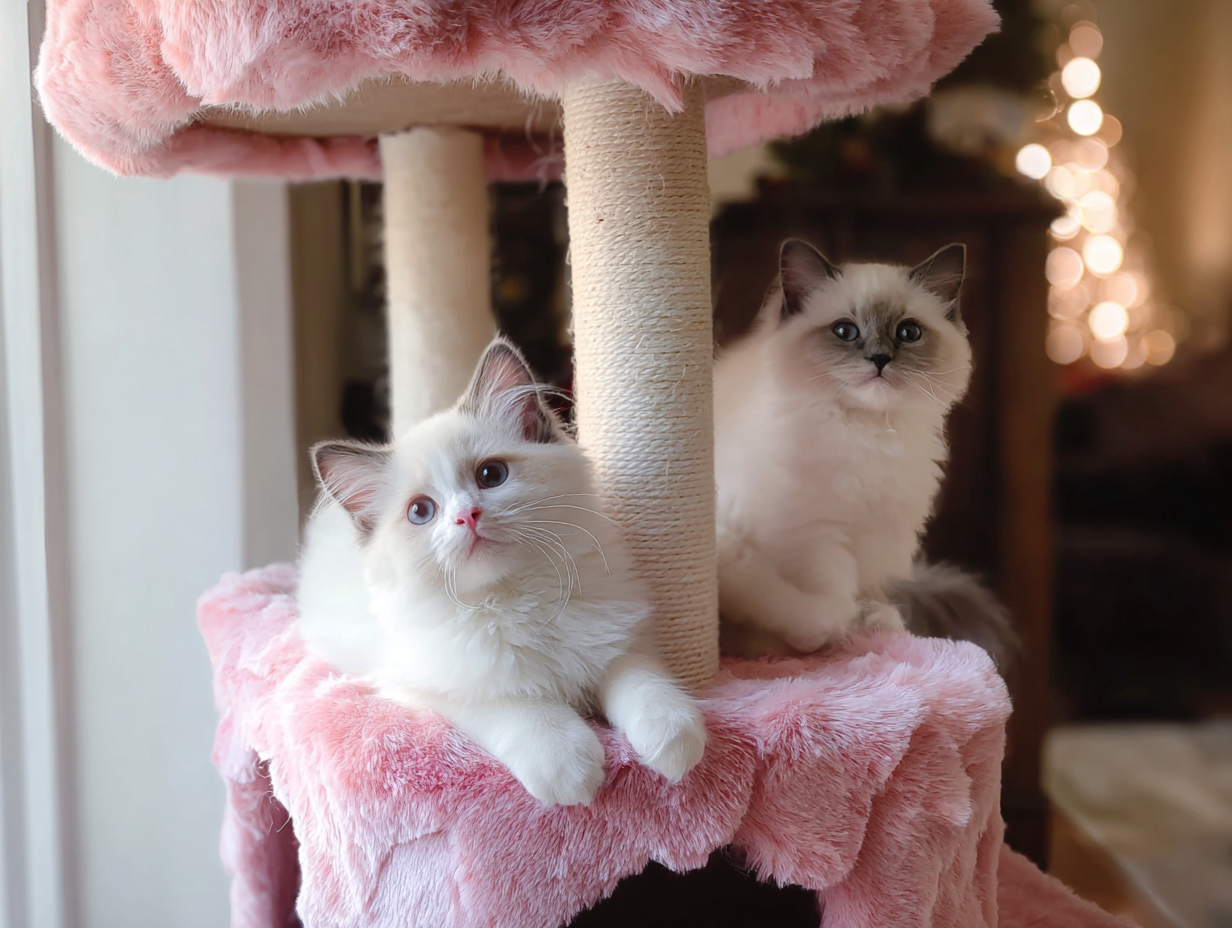
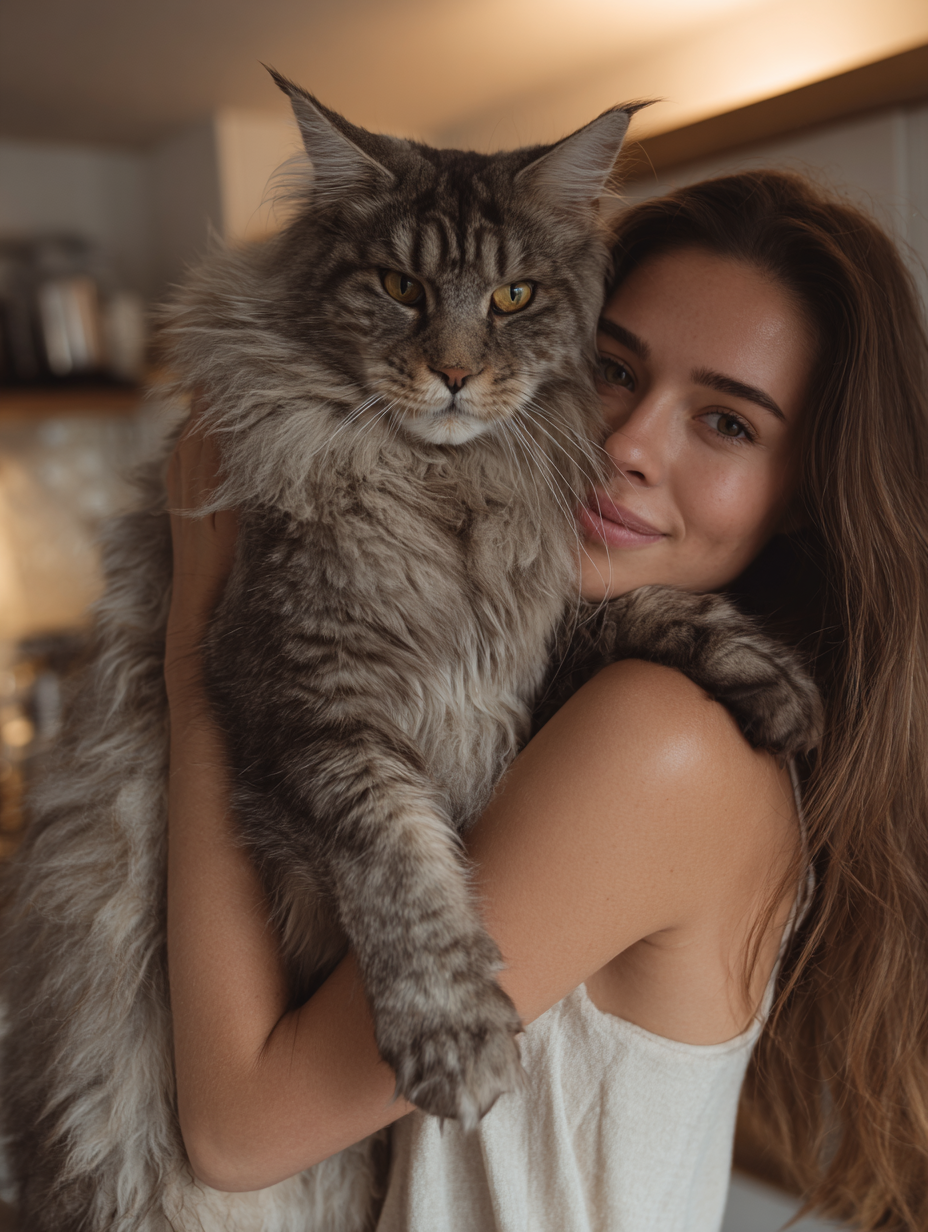


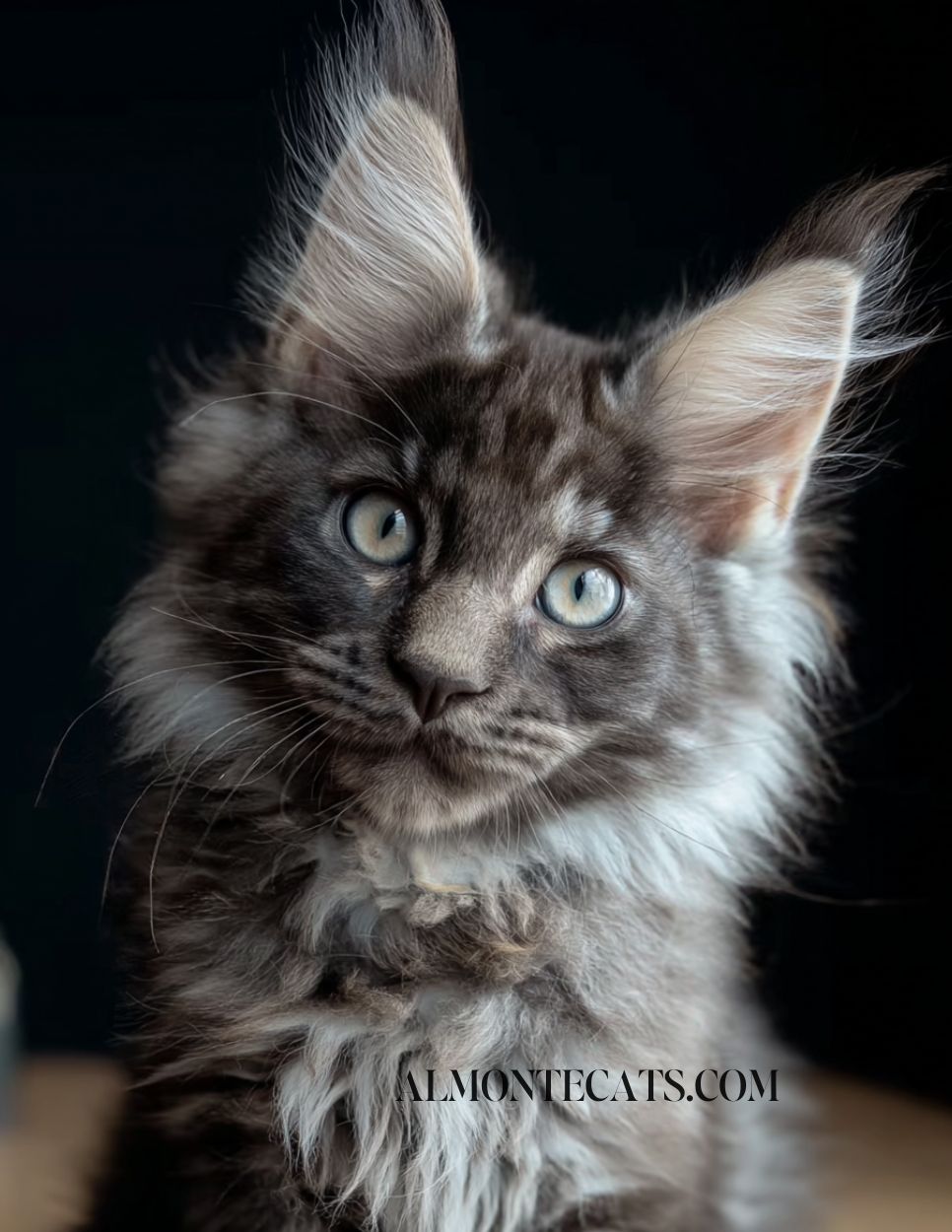
Read the Comments +